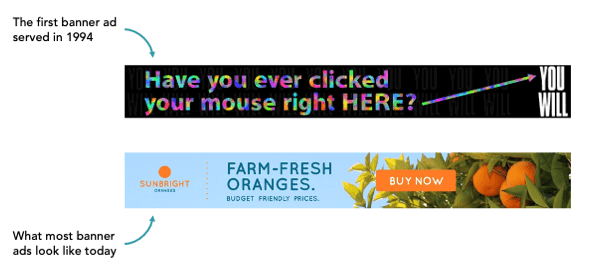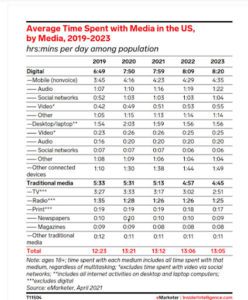Brenna Betsch and Addy Osborne, Strategists on Diglant’s Planning & Insights team, looked into why digital display advertising is (still) an effective strategy in the customer journey. Learn more about the research they uncovered and their tips when incorporating display into your media mix below!
In the world of digital advertising, it’s easy to get caught up in the latest and greatest – what’s new, trendy, and making a splash. And while these new ad formats, channels, and targeting capabilities contribute to the advancement of digital advertising, it’s essential not to overlook the tried and true digital advertising methods, such as simple (but effective) display ads.
Although this format may seem plain compared to the unique creative ad formats we see today, there are many great benefits of display digital advertising. It evolved far beyond its initial start in the digital advertising world and is now effective across the entire omnichannel customer journey. So let’s dive into why digital display advertising is still alive and well and how it adds value to your media mix!
What is Display Digital Advertising?
Display digital advertising uses images, text, and/or video combined with a link to your website, pointing consumers to learn more about your products or services. They come in various sizes and formats, including static with an image or dynamic with videos, multiple images, or other flashy elements, and served across websites, apps, and social media to an engaged or targetable audience. Traditionally these ads have been used for brand awareness campaigns and incentive site visitors and purchases.

*A banner ad, a form of display digital advertising, solely refers to the size of the ad (traditionally 468×68).
4 Ways Display Digital Advertising Adds Value to a Digital Marketing Strategy
1. Build Brand Awareness and Visibility to Support your Bottom Line
It will come as no surprise that eMarketer found sales/revenue to be the leading marketing KPI (key performance indicator) for brand marketers in 2020.
It is important to remember that driving sales doesn’t come easily or without the works of many factors doing their part to achieve this overall goal. Engagement, conversions, impression, reach, brand awareness, and traffic are all significant contributing factors that work to drive overall sales and revenue.
In 2020, advertisers agreed that display ads were in the top four for most essential channels for accomplishing their goals (falling only behind video, search, and social).
Whether high impact or standard, display banners drive a high volume of impressions and engagements, which keeps your brand top of mind with consumers. In turn, they drive sales and revenue making them a vital channel for accomplishing goals.
See for yourself! Below we’ve outlined how a display digital advertising strategy can be used in different ways and with unique formats across the various stages of the customer journey to keep your brand top of mind.

“There are dozens of partners that brands can utilize in order to make their advertisement stick out as the environment continues to grow – specifically high-impact units that include conversation banners and social to display units. By adding in these more advanced display units, advertisers see excellent interaction with both the ad itself and an increase in site activity as this type of creative is undoubtedly memorable.”
– Brenna Betsch, Strategist Planning and Insights
2. Low(er) Cost of Entry
In comparison to other digital advertising channels, it’s relatively inexpensive to get started with display advertising. With just an image and text, you can get started raising brand awareness and driving site visitors.
In addition to the low production cost, the pricing structure for display ads is usually flexible and lower. Standard pricing metrics that define success for a campaign include:
- Cost per metric (CPM)
- Cost per click (CPC)
- click-through rate (CTR)
 This chart to the right helps to show that all of these metrics remain both effective and efficient for programmatic campaigns throughout the past decade. The average Display CTR has grown by 40% from 2012 to 2018, while mobile has increased by nearly 91%.
This chart to the right helps to show that all of these metrics remain both effective and efficient for programmatic campaigns throughout the past decade. The average Display CTR has grown by 40% from 2012 to 2018, while mobile has increased by nearly 91%.
Because of the low cost of entry to get started with display ads, it’s a great tactic to add to your other marketing effort to continue to drive your brand’s message to consumers as they search and browse across different channels.
Alternatively, if you already have a presence on social media, we can use our social to display solution to lower the entry lift even more. Social display ads are authentic recreations of social media posts configured to deliver in traditional banner placements. These ads combine this great content that comes with social posts with the efficiencies and scale of programmatic.
3. Reach Consumer on the Go: Mobile Friendly Ads to Reach Mobile-First Consumers
 Since 2020, overall time spent consuming media has dropped slightly. Despite this drop, digital media consumption continues to grow. As you can see in the chart to the right, digital, and specifically mobile, has the highest amount of time consumers spend consuming media. Every day, the average consumer spends nearly 4.5 hours on their mobile device, accounting for ⅓ of all media consumption.
Since 2020, overall time spent consuming media has dropped slightly. Despite this drop, digital media consumption continues to grow. As you can see in the chart to the right, digital, and specifically mobile, has the highest amount of time consumers spend consuming media. Every day, the average consumer spends nearly 4.5 hours on their mobile device, accounting for ⅓ of all media consumption.
Interestingly, as consumers spend more time on their phones, they aren’t implementing the ad-blocking technology we see them use on their desktop devices. 60% of consumers ages 18-24 use adblocking on their desktop, while only 18% of them use these features on a mobile device. Ultimately, this means for advertisers is not a loss of money but rather a loss of supply.
That said, you’re still able to reach these users through existing channels, like mobile display, and DSPs as some users opt into acceptable ads determined by acceptableads.com. With platform-agnostic capabilities, you can pivot campaigns seamlessly between DSPs to find the best inventory for every campaign individually.
As advertisers think about how to reach digital consumers, mobile is an essential channel to include. Programmatic digital display gives advertisers the chance to reach these consumers more so than any other media channel.
4. Keep the Conversation Moving: Target and then Retarget Consumers
As mentioned above, digital display advertising isn’t a new or shiny ad format – it’s been a staple of digital advertising for over 25 years. However, what does continue to evolve and improve are the targeting capabilities for reaching your audience.
Audience insights and data are used for programmatic display ads to best reach your desired audience with where they are currently at in the customer journey. 1st party and 3rd party data are used to match your brand’s parameters across behavioral targeting, contextual targeting, site targeting, lookalike targeting, etc.
Then, with effective optimizations, display ads can be used for retargeting your consumers across the customer journey. Engage with customers who were most interested in your ads – maybe they clicked but didn’t convert or visited your site but didn’t make a purchase – across other channels with a display ad to keep the consumer interested and moving down the funnel.
Getting Started with (or increasing use of) Display Digital Advertising
“Although search typically receives credit as being the “last touch” within the customer journey, display adds value in building reach, frequency, and even view-through conversions when consumers take note of an ad and decide to search for that product or service at a later date to convert.“
– Addy Osborne, Senior Strategist, Planning & Insights
Whether using this format for brand awareness or to retarget consumers who visited your site, display advertising is a powerful tool. When used in conjunction with other marketing efforts, it will boost your brand’s overall marketing effectiveness. If you’re new to display advertising or you’re looking to increase your use, it’s a good time to start allocating more media budget this way.
Display Digital Advertising with Digilant
Digilant is your own stop shop for all things digital advertising, programmatic display ads included. We pride ourselves on data-backed decision making which means we work hard to uncover audience insights and optimize throughout entire campaigns to ensure your best audience is reached. With all your digital advertising under one roof, we’re able to quickly move and shift efforts towards channels and audiences that are seeing the best results.
Interested in learning more about Digilant’s integrated digital advertising capabilities? We’re eager to talk! Contact us today.



